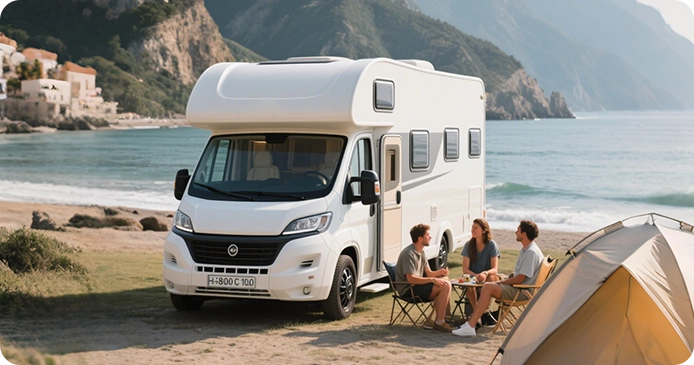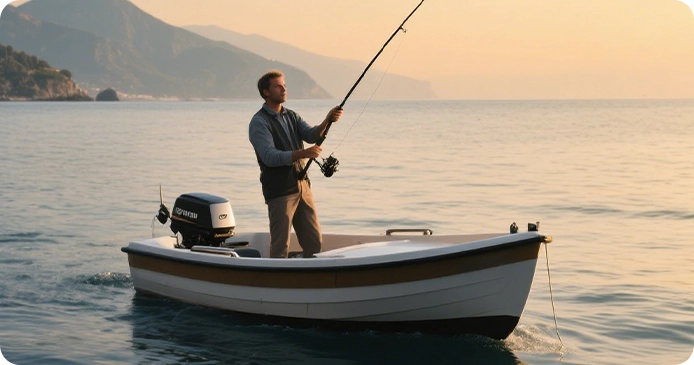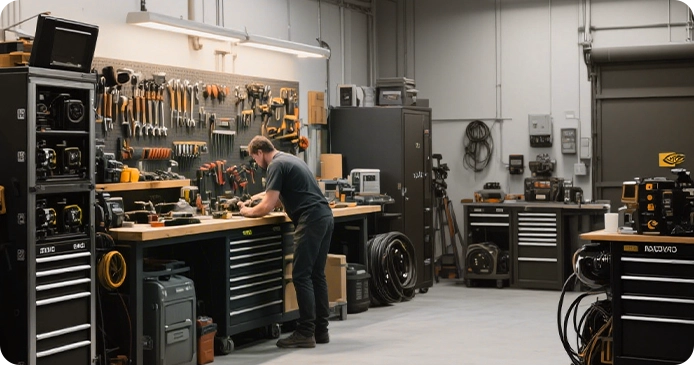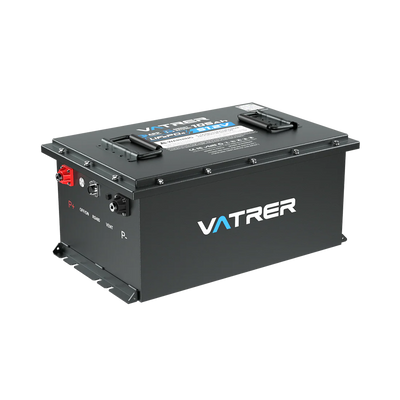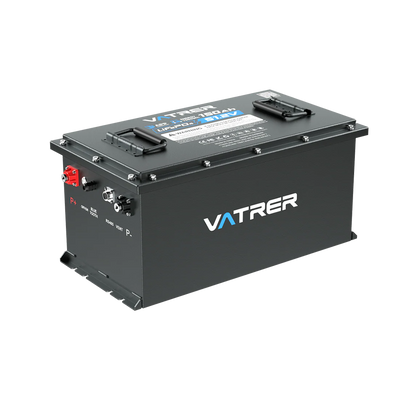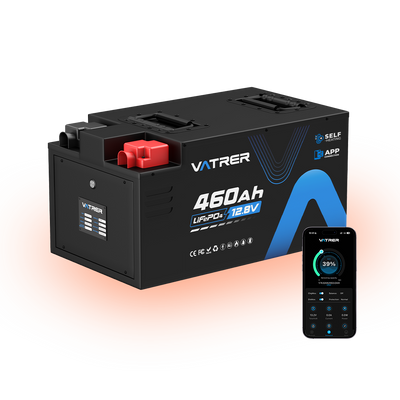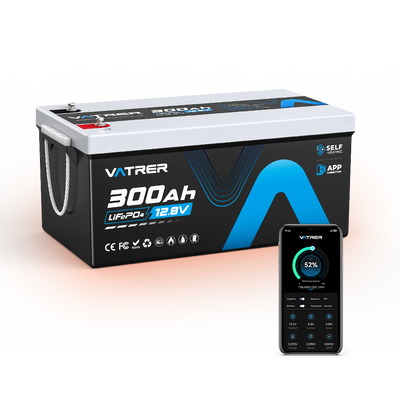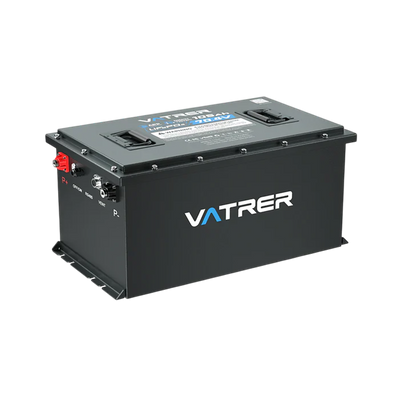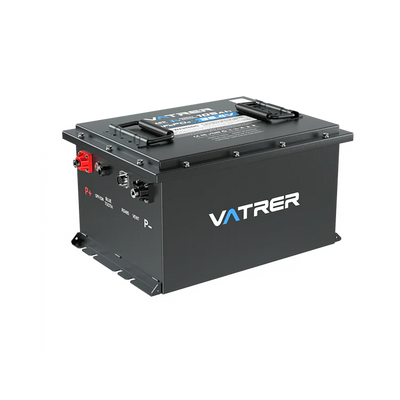
How Long Do Deep Cycle Batteries Last?
Tired of replacing batteries every few years in your solar setup or RV? If you're curious about deep cycle battery lifespan, these deep cycle batteries are crucial for steady power in applications like boats, off-grid systems, or marine gear, but their longevity depends on factors like the type of battery, usage, and care.
In this guide, we'll explore what influences how long they last and share practical tips to help you choose and maintain one effectively. This can help you avoid costly surprises and get reliable performance over time.
What Is a Deep Cycle Battery and Why It Matters for Longevity?
A deep cycle battery is engineered to provide steady power over long periods, handling repeated discharge and recharge cycles with minimal capacity loss, unlike starter batteries that deliver a short, high-current burst to start engines. This design makes them ideal for scenarios needing sustained energy, such as running appliances in RVs or storing solar power.
You'll find them in solar storage systems, UPS units, boats with trolling motors, golf carts, electric vehicles, and remote living setups. Key types include flooded lead-acid batteries, gel batteries, AGM batteries, and lithium-ion variants like LiFePO4.
Lithium options often offer higher energy density and efficiency, allowing deeper discharges without harm, which can extend overall service life compared to lead-acid models that require more cautious use to avoid early wear.
Still not familiar with the difference between deep cycle batteries and regular batteries? Read on: What are deep cycle batteries?

Exploring How Long Deep Cycle Batteries Last by Type
Deep-cycle batteries typically have a lifespan of 3 to 10 years or more, but are best measured in charge and discharge cycles, with one cycle being a full charge to a full discharge. Depth of discharge (DoD) plays a significant role, discharging to just 50% may double the number of cycles compared to discharging to 90% because shallower cycles put less stress on the battery.
Expect around 300 to 500 cycles from standard lecd-acid deep cycle batteries, though this jumps significantly with lithium types. For instance, in an RV where you cycle the battery daily for lights and appliances, a lithium RV battery can support more consistent performance without voltage drops, potentially lasting 3-5 times as long as lead-acid in real-world use.
For comparison purposes, the following table lists the performance differences between common deep cycle battery types:
| Type of Battery | Typical Lifespan (Years) | Charge-Discharge Cycles | Depth of Discharge (Recommended) | Maintenance Level |
|---|---|---|---|---|
| Flooded Lead-Acid | 3-5 | 300-500 | 50% | High |
| Gel | 4-7 | 500-1,000 | 50-70% | Medium |
| AGM | 4-7 | 500-1,000 | 50-80% | Low |
| Lithium (LiFePO4) | 8-10 | 2,000-5,000 | 80-100% | Very Low |
Because lithium deep-cycle batteries utilize lithium iron phosphate chemistry, they offer more stable and safe performance, and their lifespan is significantly longer than other batteries.
If you're looking for a reliable lithium battery for your RV camping needs, the Vatrer 12V deep-cycle battery is a great option. For more information on RV deep-cycle batteries, read: What's the Best Deep-Cycle Battery for RVs?
Key Factors That Affect the Lifespan of a Deep Cycle Battery
Understanding the typical lifespan of different battery types isn't absolute. Individual usage habits and environments vary, which can also affect battery lifespan. Below are the main factors that can affect the lifespan of deep-cycle batteries. Identifying these issues early can help you adjust your habits and prevent premature battery failure.
Maintenance Practices: This is a core element in battery care. For flooded lead-acid batteries, regularly check electrolyte levels to prevent plate exposure, which can lead to irreversible damage, and clean terminals to avoid corrosion that blocks current flow. AGM and gel batteries need less frequent attention but still benefit from periodic inspections. Lithium batteries make things easier with a built-in battery management system (BMS) that automatically protects against common issues, cutting down on manual errors and extending usability.
Tip: Set a monthly reminder for checks to catch problems before they shorten life.
Temperature Conditions: Heat and cold directly affect the battery's internal chemistry. Every 10°C increase above 25°C (77°F) can reduce lifespan by 20-50% by speeding up degradation reactions, while low temperatures mainly lower temporary capacity without as much permanent harm. For best results, store and operate batteries in a 50-77°F (10-24°C) range. In extreme climates, consider insulated enclosures or temperature-controlled storage to maintain consistent performance.
Operating Environment: Beyond temperature, the setup around your battery matters. Ensure good ventilation, especially for lead-acid types, to disperse hydrogen and oxygen gases produced during charging, this prevents dangerous buildup and supports longer, safer operation. Poor airflow can lead to overheating or corrosion, so install in well-aired spaces away from moisture or dust.
Usage Patterns: How you draw power influences wear over time. Factors like high power demands or frequent deep discharges (high DoD) accelerate aging by stressing the cells. In lead-acid batteries, this often causes sulfate buildup on plates, increasing internal resistance and permanently cutting capacity. Lithium options fare better, as their BMS helps regulate these stresses for more even efficiency.
Tips: Monitor your load with a meter and aim for moderate discharges to balance energy needs with longevity.
Battery Quality and Design: Not all batteries are built the same, higher-quality models use superior materials and manufacturing that better resist stress and degradation. Cheaper options might fail sooner under the same conditions. When choosing, look for reputable brands with warranties tied to cycle counts, like Vatrer Battery, as this reflects durable construction suited to your application.
Thinking about upgrading or replacing your batteries? Vatrer deep-cycle batteries all have built-in BMS and low-temperature protection. They also come in a variety of sizes and designs, including self-heating. Whether you're using them for an RV, an electric golf cart, or even a solar installation, we have a battery to meet all your needs!
Practical Tips on How to Extend the Lifespan of Deep Cycle Batteries
By understanding the other factors that affect the life of deep-cycle batteries, you can implement targeted strategies to extend battery life, just like performing preventative maintenance on power supplies. Here are some practical tips to make it easy for you to implement:
Proper Charging Techniques: Always use a charger specifically compatible with your battery type to prevent overcharging or undercharging, which can degrade cells over time.
For lead-acid batteries, perform an equalization charge every 1-3 months to balance voltage across cells and reduce sulfation. Connect the charger and follow its settings for a controlled overcharge.
Lithium batteries recharge more quickly and efficiently, often reaching full charge in half the time of lead-acid, but avoid using lead-acid chargers as they may not provide the correct voltage profile, leading to incomplete cycles or potential damage.
Tip: Invest in a Vatrer smart charger with automatic shutoff for safer, hands-off operation.
Routine Maintenance and Inspections: Regular upkeep is key to catching issues early. Inspect battery terminals for corrosion every month and clean them with a baking soda-water mix and a wire brush to ensure strong electrical connections.
For flooded lead-acid types, check and top up electrolyte levels with distilled water to keep plates submerged, preventing dry-out and capacity loss, do this after charging to avoid overflow.
AGM and gel batteries are sealed and need minimal intervention, while lithium models are virtually maintenance-free thanks to their BMS.
Tips: Keep a log of inspections to track patterns and address recurring problems promptly.
Optimal Storage Practices: When not in use, store your battery properly to minimize degradation. Maintain a 50-70% charge level to avoid deep discharge during downtime, and place it in a cool, dry, well-ventilated area away from direct sunlight or freezing conditions, ideal temps are 50-77°F (10-25°C).
If the battery sits idle for more than a few months, recharge it periodically to counteract self-discharge, which is lower in lithium (about 1-3% per month) compared to lead-acid (up to 15%). For long-term storage, disconnect terminals to prevent parasitic drains.
Tips: Use a battery maintainer trickle charger for extended periods to keep it topped up without overcharging.
Monitoring and Usage Alignment: Stay proactive by monitoring performance and matching usage to the battery's capabilities. Many lithium batteries include apps or Bluetooth monitors to track real-time data like voltage, temperature, and cycle count, allowing you to spot anomalies early.
For all types, avoid exceeding the recommended depth of discharge, stick to 50% for lead-acid and up to 80-100% for lithium to reduce wear. Use tools like a multimeter or battery monitor to gauge loads and adjust habits, such as grouping high-draw devices to shorter sessions.
Tips: This data-driven approach can extend life by 20-30% by preventing overuse, especially in variable setups like solar or marine applications.
Explore Vatrer solar batteries and marine lithium batteries, or deep cycle batteries for other applications. Vatrer batteries all support Bluetooth connection to monitor battery status in real time. For golf cart batteries, we also have an external display function to achieve dual monitoring mode.
Conclusion
In review, deep cycle battery lifespan varies by type, lithium LiFePO4 models deliver 8-10 years and 2,000-5,000 cycles versus lead-acid's 3-5 years, shaped by maintenance, temperature, and usage. Focusing on proper charging and environment can extend this significantly.
For upgrades, Vatrer lithium deep cycle batteries provide advantages like built-in BMS for overcharge, over-discharge, over-current, short-circuit, and low-temperature protection, fast charging with 100% efficiency, lightweight design for easy RV or boat handling, IP65 waterproofing, and A-grade cells supporting 4,000+ cycles. Evaluating your setup and exploring Vatrer deep cycle battery options could ensure longer, reliable power.
For more information about deep-cycle batteries, read the following:
What is a 12V deep-cycle battery?
Can the LiveScope be used with deep-cycle batteries?
What are the main uses of deep-cycle lithium batteries?
FAQs
Is It Worth Switching From Lead-Acid To Lithium Deep Cycle Batteries?
Switching to lithium from lead-acid can be worthwhile if you prioritize long-term savings and performance, as lithium batteries typically last 8-10 years with 2,000-5,000 cycles, compared to lead-acid's 3-5 years and 300-500 cycles.
While lithium has a higher upfront cost (often 2-3 times more), it offers benefits like lighter weight (up to 50% less), faster charging, and higher usable capacity without sulfation risks.
Over time, this reduces replacement frequency and maintenance costs. For example, in a solar or RV setup, you might save $500-1,000 over 10 years by avoiding multiple lead-acid swaps. However, if your usage is light or budget is tight, lead-acid might suffice.
How Do i Know When To Replace My Deep Cycle Battery?
Signs of needing replacement include reduced runtime (holding only 70-80% of original capacity), slower charging, bulging cases, or voltage drops below 10.5V under load for 12V batteries.
For lead-acid, sulfation or low specific gravity readings (below 1.225) indicate irreversible damage, lithium batteries might show BMS errors or inconsistent app readings.
Batteries often reach end-of-life after 80% capacity loss, which could happen after 300-500 cycles for lead-acid or 3,000+ for lithium.
Regularly testing with a multimeter or load tester can catch this early.
Suggestion perform capacity tests every 6 months, discharge to recommended DoD and measure recharge time.
Can Deep Cycle Batteries Perform Well In Cold Weather, And How To Optimize Them?
Deep cycle batteries can work in cold weather, but performance drops as temperatures below 32°F (0°C) reduce capacity by 20-50% due to slowed chemical reactions, lead-acid suffers more, potentially freezing if not fully charged, while lithium handles down to -4°F (-20°C) better but may need heating features.
Low temps don't shorten lifespan permanently if managed, unlike heat. For marine or off-grid use in winter, capacity might halve, affecting runtime.
Suggestion use insulated battery boxes or blankets for protection, and opt for batteries with low-temperature cutoff or self-heating, like some Vatrer lithium models that activate heating below 32°F. Always charge in warmer conditions and monitor with a thermometer-integrated BMS to maintain efficiency.
How Long Do Deep Cycle Marine Batteries Last?
Deep cycle marine batteries, designed for boats and trolling motors, typically last 3-6 years for lead-acid types, like flooded or AGM, under regular use, with 300-1,000 cycles depending on maintenance and exposure to moisture.
Lithium (LiFePO4) versions can extend this to 8-10 years or more, offering 2,000-5,000 cycles due to better resistance to vibration and corrosion in wet environments.
Factors like saltwater exposure can shorten life if not addressed, but proper care, such as rinsing terminals and using waterproof casings, helps.
In frequent cycling scenarios, like daily fishing trips, lead-acid might need replacement every 2-3 years, while lithium could go 5+ years.
Suggestion choose marine-rated batteries with IP65 waterproofing, like the Vatrer marine lithium battery, and test capacity annually with a hydrometer or multimeter to predict failures early, potentially saving on downtime costs.
How Long Can a Deep Cycle Battery Last Without Charging?
Without charging, a deep cycle battery's duration depends on whether it's in use or idle. For active loads, a 100Ah battery at 10A draw might last about 10 hours before deep discharge, but this varies by type, lithium holds voltage longer for more consistent output.
Idle (no load), a well-maintained battery can retain usable charge for up to 6 months, thanks to low self-discharge rates (1-3% monthly for lithium vs. 5-15% for lead-acid), though cold temps or age accelerate this. Beyond that, sulfation or capacity loss sets in, risking permanent damage.
Suggestion for storage, keep at 50-70% charge and use a maintainer charger every 3 months to top up without overcharging, monitor with a voltmeter (aim for above 12.4V for 12V batteries) and opt for low-self-discharge lithium models like Vatrer's to extend idle periods safely in setups like seasonal RVs.
Share







































































